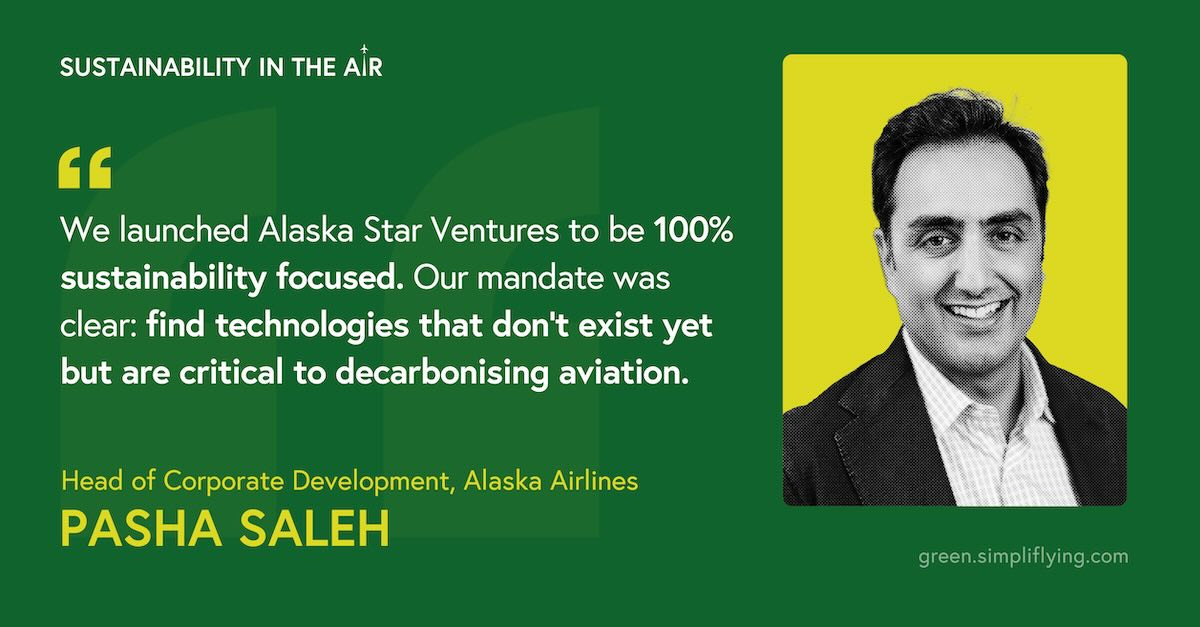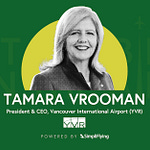In this episode of our ‘Sustainability in the Air’ podcast, Pasha Saleh, Head of Corporate Development at Alaska Airlines, speaks with SimpliFlying’s CEO Shashank Nigam and shares insights on how the airline is investing in sustainable aviation technologies to achieve its ambitious climate goals. Saleh leads Alaska Star Ventures, the airline’s corporate venture capital arm focused on sustainable aviation technologies.
As a pilot with 37 years of flying experience and head of Alaska Star Ventures, Saleh brings a unique perspective to identifying and investing in technologies that can transform aviation while maintaining the industry’s high safety standards. With approximately $90 million deployed across various investments, Alaska Airlines is taking a strategic approach to decarbonising aviation.
Here are the key highlights of the conversation:
The founding vision of Alaska Star Ventures and the "Kennedy moment" (2:32)
Sustainability as the core focus for investments (5:49)
The “crawl-walk-run” approach to venture investing (9:27)
Strategic approach to sustainable aviation fuel (SAF) (19:09)
The “Three Horizons Framework” for balancing investments (23:29)
Ensuring practical implementation of new technologies (26:40)
The unique value of pilot experience in venture investing (39:27)
Rapid fire! (41:13)
Keep reading for a detailed overview of the episode.
Why strategic sustainability investments matter for aviation’s net zero transition
Alaska Airlines’ approach to sustainability investments seeks to address a fundamental challenge: the technologies needed to decarbonise aviation largely don’t exist yet or operate only at a laboratory scale, says Saleh. The airline has also set ambitious climate targets of achieving net zero emissions by 2040 — a full decade ahead of the industry’s target.
“We set ambitious climate goals, and it quickly became clear that achieving them would require technology that doesn’t yet exist,” says Saleh. “I see it as a John F. Kennedy moment, when he challenged the nation to land a man on the moon. The technology to do so didn’t exist at the time.”
To bridge the gap and accelerate progress, the airline launched Alaska Star Ventures (ASV) in 2021 to support technologies that drive its net-zero goal and broader industry advancements. While sustainability remains its core focus, ASV also explores complementary opportunities in operational efficiency and safety, positioning Alaska Airlines as both an adopter and a driver of new technologies.
The focus on sustainability also presents significant business opportunities, says Saleh. “As important and exciting as sustainability is, it will give rise to entirely new industries that don’t exist today,” he notes.
By taking equity positions in emerging sustainable aviation technologies, Alaska Airlines hopes to advance its climate goals while potentially securing advantageous positions in the industries of tomorrow.
4 takeaways from the conversation
1. The crawl-walk-run approach to venture investing
ASV adopted a deliberate “crawl-walk-run” approach to investing, starting with partnerships with established funds to build expertise and gain insights into emerging technologies.
“We knew we needed new technology, but airlines typically don’t employ investment bankers. So, how do we learn about investing?” posits Saleh. The answer came through strategic partnerships with funds like UP.Partners and The Westly Group.
After gaining experience from these established investors, ASV began making direct investments in promising startups. The next step in its evolution was a partnership with UP.Labs, a venture studio focused on creating startups to address specific corporate challenges.
This collaboration allows Alaska Airlines to develop solutions for problems where no existing startups may be available. Through UP.Labs, the airline is developing six new software companies, including Odyssey, an AI-powered flight scheduling optimisation system.
2. Revolutionising aircraft design with JetZero
One of Alaska Star Ventures’ most exciting investments is in JetZero, a company developing a revolutionary blended-wing aircraft that could reduce fuel consumption by up to 50% compared to current commercial jets.
What makes JetZero particularly promising is that it relies on existing technology arranged in novel ways, says Saleh. “It’s based on principles that have been studied for decades, and the technology to build it is already available off the shelf,” he notes.
“It uses narrow-body engines on a wide-body platform and composite structures similar to those in the Dreamliner. It’s not dependent on a fuel that doesn’t exist yet.”
As the first airline investor in JetZero, Alaska Airlines has helped form an airline customer advisory board to ensure that the blended-wing design meets practical operational needs. This collaborative approach brings together engineers, scientists, and airline operations experts to address considerations that only those with extensive operational experience would recognise.
“If you’re not close to your end customer, you might develop something that’s out of touch,” shares Saleh, explaining the vision behind the advisory board. “You need that connection to the commercial side. What will an airline pay for? What are the pain points of operating your product? Will it fit into the existing network and systems airlines already have?”
3. Strategic approach to sustainable aviation fuel (SAF)
With SAF representing one of the most promising and readily available pathways to net zero that works with existing aircraft, ASV has made strategic investments in two Power-to-Liquid (PtL) SAF producers: Twelve and Air Company.
“Of all the ways to produce SAF, PtL is in the earliest stage of development, where we have the most to learn,” explains Saleh. “It also holds the most potential upside. Theoretically, you could create a limitless supply of fuel from just air and water. It’s like magic – if it works.”
However, Saleh also acknowledges the challenges of scaling SAF to meaningful levels. “SAF is clearly our biggest lever for decarbonising aviation, but scaling SAF demands project-level financing, which far exceeds what corporate venture capital (CVC), especially an airline CVC, can typically support.”
He explains that traditional venture capital is not well-suited for SAF investments due to its focus on shorter-term returns: “I can’t tell my investment committee that we’re going to make this investment and not see returns for decades.” Scaling SAF, he adds, is a monumental, multi-party effort that will take time.
Instead of trying to fund the full-scale production facilities, Alaska’s strategy is to secure “a seat at the table” through limited investments in PtL technology at an early stage. This enables the airline to monitor technological progress while avoiding the capital-intensive challenges of scaling production.
4. Ensuring practical implementation through operational involvement
For Alaska Star Ventures, the key criterion for any investment is whether it can be successfully implemented in the real world.
“If it can’t be operationalised, then it’s not useful,” Saleh emphasises. “It’s essential that we invest in something we can actually implement and not have it be a science project.”
This philosophy guides the entire investment process, from initial screening to due diligence. “One of the things we’ve done is involve operational teams as early as possible,” explains Saleh. “If I get an idea, I’ll reach out to a colleague in operations and ask, ‘What do you think about this? Could you see your team using this?’”
As an example, Saleh illustrates the story behind Alaska’s investment in Assaia, a startup that uses computer vision and machine learning to improve aircraft turnaround processes.
“There are about 80 steps involved in getting an airplane from the gate, unloaded, reloaded, and ready for takeoff,” explains Saleh. Assaia’s technology leverages existing airport cameras to monitor these steps, creating timestamps and alerting staff to delays. By minimising delays and optimising turnarounds, Assaia reduces both fuel consumption and emissions. Alaska initially became a customer before investing in Assaia’s Series A round.
As Alaska Airlines looks to integrate technology investments with its expanded fleet following the Hawaiian Airlines merger, Saleh’s approach of grounding innovation in operational reality will be essential for achieving the airline’s ambitious sustainability goals.
For March 2025, we’re pleased to feature 4AIR as our exclusive Sponsor of the Month. 4AIR is leading the way with the industry’s first framework to address aviation’s climate impact – offering clear, verifiable pathways to reduce and counteract emissions. Discover their services, including compliance monitoring and The Assure SAF Registry, to advance your sustainability efforts.














